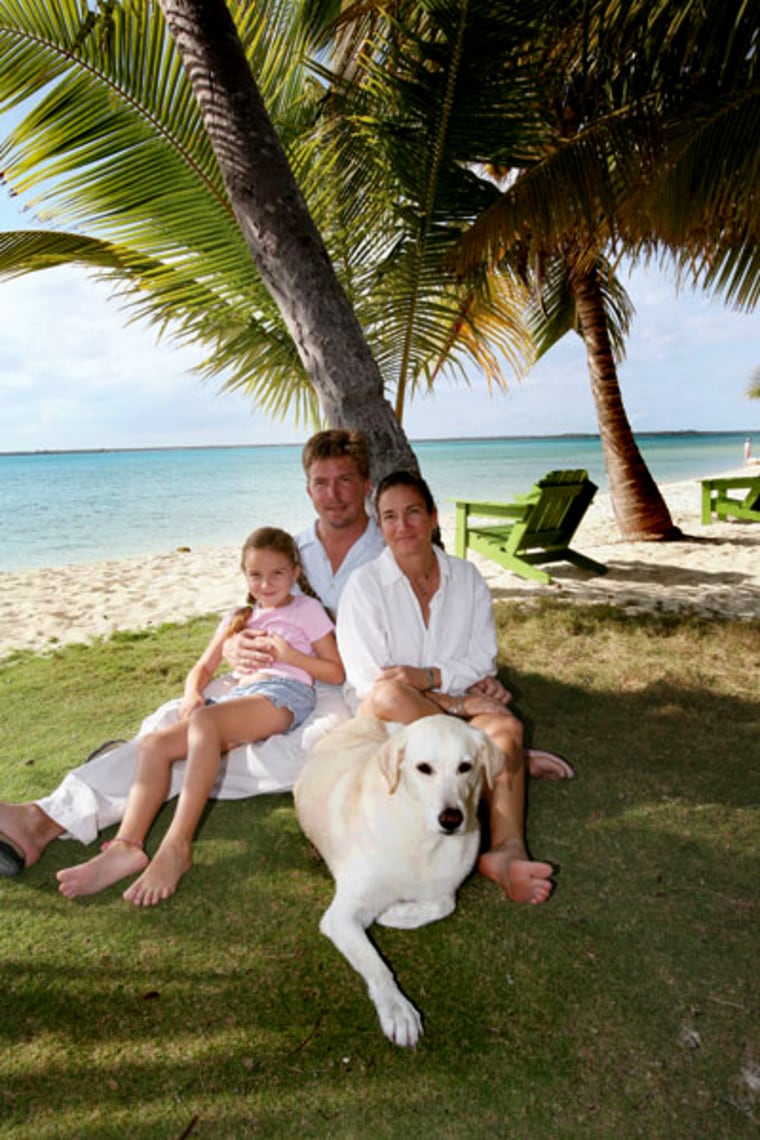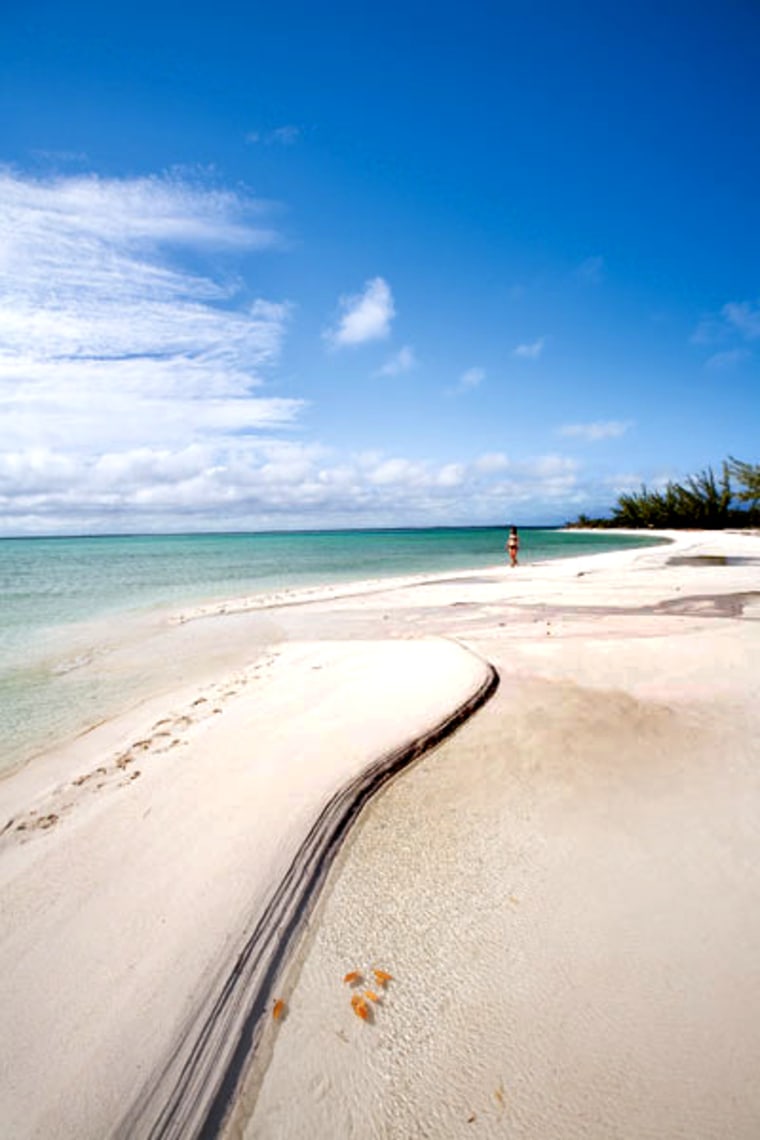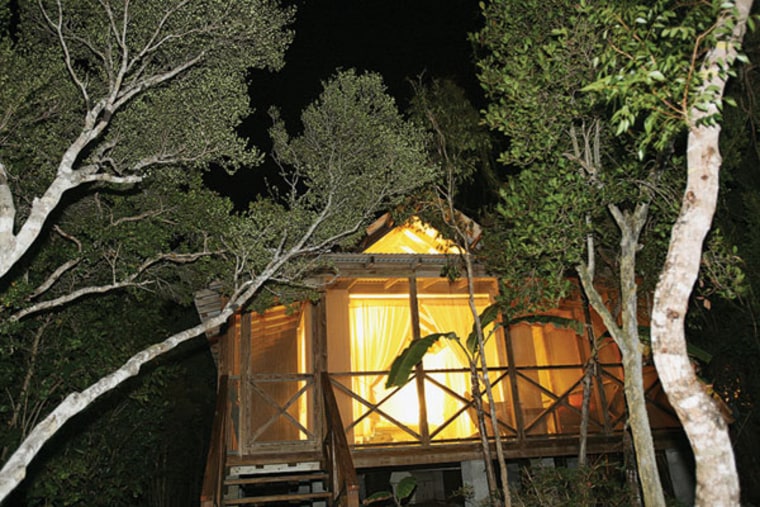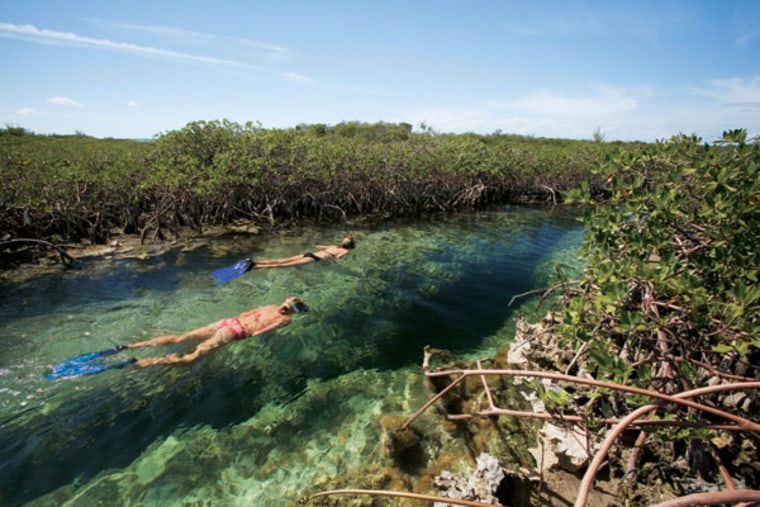On unspoiled Andros Island in the Bahamas, one little resort has been tranquilly cruising far ahead of the wave of environmentally friendly theory and practice and has created a model for the future of low-impact Caribbean tourism – all without a single guest having to bathe in a bucket. ...
“I hate the term ‘eco-resort.’”
This statement blows me away, coming as it does from Mike Hartman, who owns Tiamo Resort, one of the world’s most successful … uh … something-or-other-kind of hotels that’s exactly what I’ve always considered an eco-resort.
“In many people’s minds,” he says, “‘eco-resort’ implies sleeping on a cot, bathing in a bucket, reading by flashlight and eating twigs and berries.”
We, however, are lounging on cozy wicker couches set beneath ceiling fans, sipping icy cocktails in the bar of Tiamo’s main lodge. And about 50 yards down the sugary white-sand beach, tucked just behind a screen of sea grapes, is my roomy bungalow equipped with an Olympic-sized bed, steaming hot shower and full-zap electricity.
Mike, 38, has a puckish smile and often jumps behind the bar to invent new drinks for guests and serves as funk-master DJ at staff celebrations. But he’s also very thoughtful and deliberate, especially when his Hoosier twang gets going about anything eco. His particular experience of creating and running Tiamo has made him much in demand as a speaker and consultant on sustainable tourism, a topic that is suddenly getting a lot more attention as the entire world focuses on pressing environmental issues.
It wasn’t the global problems, though, that led Mike and his wife Petagay to come up with the concept for Tiamo in 1996. “We simply wanted to build a little hotel in a beautiful place,” says Petagay, 41, who was born and raised on Jamaica. Mike, a Midwestern farm boy who’d gone into publishing, wound up at the wild and wacky end of Florida, Key West, on a sabbatical that he figured was his last gasp of freedom before fast-tracking it in New York. However, when he met the free-spirited Petagay, who was working tourism jobs in Key West after spending a couple of years doing marketing for SuperClubs back in Jamaica, Mike realized that maybe he could find something more interesting to do with his life.

The couple decided early on that they’d have to look around to find the right spot for their hotel. “The Keys were out,” says Mike. “Water quality and reef quality had already been devastated by poor land-use planning, overdevelopment and disasters like septic systems that leaked into the ocean and Florida Bay.” Not far away, though, across the cleansing waters of the Gulf Stream, lay islands that were like the Florida Keys sent back in time. The Hartmans did six months of scouting trips to the Bahamas’ Out Islands, concentrating on Andros, the largest yet least developed and populated. “We were searching for a place that hadn’t been impacted yet,” says Mike. “And there are areas of Andros that still, to this day, haven’t been explored.”
The spot they finally found was tucked inside South Bight, one of the tidal “creeks” that slice through the 2,300-square-mile island. A tiny settlement called North Quarter was just a few crumbling ruins surrounded by miles of uninhabited coppice and sun-baked limestone, inaccessible except by boat or seaplane. It stood behind a stunning stretch of beach that was forgotten by everyone except a few locals who came to dive conch and go ashore for the occasional picnic. Navigating the Byzantine backwaters of Bahamian land ownership, Mike and Petagay discovered a small plot of privately owned land along that beach. They’d found their beautiful place.
For the Tiamo concept to succeed, the Hartmans knew that the hotel would have to serve as a gateway to extraordinary natural areas. The day before sitting down with Mike and Petagay, I’d boarded a boat with one of the resort’s “nature concierges,” all of whom are bona fide biologists. We motored west, following the Bight deep into the mangrove maze that makes up much of Andros. At a spot called Miller’s Creek, the boat crew tied up to a tree and helped us overboard into kayaks.
The trip was timed to take advantage of the tidal flow, so paddling was mostly a matter of steering down the watery trails or holding steady in the current to more closely examine marine life clustered around the mangrove roots. Ibises, herons and a belted kingfisher winged above the wetland while sea turtles and tarpon periodically broke the calm surface. As clouds passed overhead, they began to glow blue, a mystery until we floated around a bend and came upon a vast shallows that was reflecting its aquamarine tint up into the sky. A trio of Andros’ famed bonefish dug for prey in the flat’s sandy bottom, their silver tails up and wagging. We nosed the kayaks into the skinny water and sat for a long moment taking it all in, talking about how, if we kept going south or west, we wouldn’t run into another human until we hit Cuba.
Earlier, I’d joined a small group of guides and guests heading just east of the resort to see one of the Caribbean’s most amazing natural attractions: The Crack, part of a 93-mile fracture that connects the world’s longest string of blue holes, those bewitching sapphire eyes that stare up from both land and sea all around Andros and serve as watery entrances to its subterranean wonderland of caves.
We waded up an estuarine stream until it widened into a gently sloping pool and then donned our snorkel gear. One by one we dove underwater and swam through a limestone cave that quickly emerged into a briny lake edged in wickedly sharp ironshore. Following our guide, we finned through the shallow water along a low rock wall festooned with tunicates and sponges until we turned a corner and, suddenly, the bottom dropped away into a dark, fathomless slit. Hanging weightless at the lip of this mesmerizing geological feature was the finest in Freudian snorkeling.
Surrounded by both inland and oceanic blue holes with the world’s third-longest reef system just to the east and endless bonefish flats and mangrove forests stretching away to the west, north and south, the site the Hartmans found for Tiamo was indeed a nexus of natural attractions. “When you added in the distinctive local culture of South Andros with its bush medicine, its traditional fishing, its Junkanoo,” says Petagay, “we felt that this spot had such a specialness, a wonderful sense of place.”

“The real challenge, then,” says Mike, “was how to build and operate a hotel here, how to attract people to this pristine area while preserving that sense of place.”
It’s the burning question throughout the Caribbean these days: How do you build somewhere for visitors to stay without destroying the features – the beaches, the reefs, the local culture – that they came to experience?
“The traditional way to do construction in a place like this,” says Mike, “is to bring in heavy equipment and conquer nature.” Even within the Out Islands, a collection of islands and cays of unparalleled beauty where all the most popular attractions – diving, snorkeling, fishing, beaching and boating – are nature-based, there are recent examples of poor planning. Struggling to improve the lives of its people by creating jobs throughout the country, the government allowed one offshore developer to chew through an island and gouge out an oversized marina, piercing and spoiling the supply of fresh water that had always fed three villages. Another developer dredged and filled a tiny island’s fragile harbor to build a golf course that will serve clientele primarily from Florida, which is a 20-minute flight away and already has more than 1,000 golf courses. The result of damaging the environment, alienating local people and building nondescript hotel rooms, condos and homes straight out of a Florida subdivision is complete destruction of the unique character and appeal of an exotic destination. And it’s what the Hartmans wanted to avoid at all cost.
“The amazing thing is,” says Mike, “that the cost of building Tiamo and doing business the right way turned out to be much less than doing it the traditional way.” Instead of bringing in bulldozers to level the mangroves and scrape the land clean, they cleared the building sites surgically, by hand, with machetes and chain saws.
“If we’d brought in big machines,” says Mike, “we’d have had to dredge the bight and build a massive pier, both of which would have damaged the beach and the snorkeling sites we have right out front.” Instead, they landed all the building materials by small boat, keeping a large local crew busy throughout the construction. Clearing by hand meant that they removed exactly the amount of trees and plants necessary to build the bungalows and the lodge, which were all cleverly sited so they’re invisible from the water. Even from just offshore, the only signs that there’s a resort here are the small dock and a few sailboats and kayaks on the sand. “And because we didn’t tear everything out,” says Petagay, “we didn’t have the expense of replanting.”
The first guest bungalow was actually built in Indiana at Mike’s dad’s place so they could measure the lumber needed to the inch and count supplies down to the nail before they began to buy and ship materials to Andros. The building designs look simple, but every element – the stilts, the wide covered porches that wrap around the bedrooms, the high ceilings and white roofs – was planned to minimize environmental impact and maximize cooling airflow.
“Our construction costs were six times less than they would have been if we’d done it the more destructive way,” says Mike. “And because we designed everything for maximum efficiency, we were able to realize one of our original goals and become the world’s first full-service resort to be 100 percent solar-powered – the rooms, the lodge, the business office, lights, ceiling fans, computers, even the restaurant and commercial kitchen, all solar.” By making the initial investment in photovoltaic panels and solar water heaters, Tiamo didn’t have to purchase big, greenhouse-gas-spewing generators, and now all their power is effectively free. “It’s sunny all the time down here,” says Mike. And just in case the Andros sun goes on vacation for more than three days, they have a small backup generator that runs on biodiesel.

Every other system at the resort also works to protect the environment and the bottom line: Bulk purchasing minimizes packaging and waste, and using compost toilets eliminates both groundwater pollution and the cost of a sewage-treatment plant.
From the Bahamian government’s standpoint, Tiamo has been a boon to South Andros. Without having to run roads, power, water or sewer lines to the resort, the country has relatively little invested in the operation. In return, though, they get a thriving, tax-paying business with 34 people – all of whom, except for a handful, are local Bahamians – on its payroll. Tiamo has provided no-interest loans to fund a taxi operation and has helped five fishermen buy boats to start their own businesses as bonefish guides; each now earns $350 a day.
Tiamo excels in nearly every major index of the eco-friendly and sustainable-tourism world. “But we continue to struggle with food,” says Mike. “We’d love to be able to buy everything locally, but it’s just not possible yet.” The main reason is that they refuse to buy and serve grouper, lobster or conch because each has been seriously overfished in the Bahamas. Unfortunately, those species are still what the Andros fishermen are accustomed to going after. So instead, the other guests and I have been enjoying mahi-mahi, jerked lamb, crab cakes, oysters and seared tuna, all shipped or flown in from off island.
I figured that a resort displaying such a strict eco-cred would be attracting a seriously crunchy clientele.
“Oh, heavens no,” said Brian Appleby, sitting on the beach in the shade cast by a stand of casuarinas. “I don’t pay any attention to eco-this or eco-that, and as far as what I eat … the more endangered the better.” I’d met Brian and his wife, Lynda, at the long, family-style dinner table and knew he was a big kidder, but I did believe that the fleshy former English magistrate would have no trouble at all stomaching Black Rhino steak and Giant Panda pate as long as they were prepared just right. After traveling all over the world, including many safaris in Africa, the Applebys had returned to Tiamo for the fifth straight year. As on previous trips, they were staying for three weeks. “It’s just what we’d always been looking for,” said Brian. “We can relax and read; it’s so quiet and peaceful. And the people, the staff here, are lovely, just lovely.” My questions about the importance of the resort’s sustainability and environmental awareness were met with dismissive waves. “Lynda enjoys the activities,” said Brian, “but I’m here … Do you speak Italian? I’m here bel far niente, ‘for the pleasure of doing nothing.” And this is the perfect place to do it.”
Mike is not surprised when I tell him that out of a full house of 22 guests, I haven’t found a single one who says they’re here because of Tiamo’s eco-reputation. “We don’t market that way, even though we’re as eco as possible,” he says. He feels that it makes the low-impact way they operate even more valuable. “We’re not preaching to the choir,” he says. “People come here simply looking for a natural destination. Once they take our behind-the-scenes tour, though, we really see an impact.”
“Many of them leave thinking differently,” says Petagay. “They may not go home and trade in their Escalade for a Prius, but we get a lot of letters telling us how they now take their recycling and water and energy conservation more seriously.”
Tiamo’s achievements at the leading edge of sustainable tourism may soon spread beyond this one Out Island, as plans are underway to use the award-winning Tiamo model, along with everything Mike and Petagay have learned along the way, to create several more something-or-other-but-not-eco resorts in other special places.
“The truth is,” Mike says, “that running a resort like this instead of the business-as-usual, crush-and-conquer method is the way to make it both profitable and to ensure that you preserve what people are traveling for in the first place.”
is the magazine for anyone in search of the perfect tropical getaway. Each issue presents expert insider’s advice on where to find the Caribbean’s best beaches and attractions, its finest resorts and spas, liveliest beach bars and activities, and its friendliest people.
